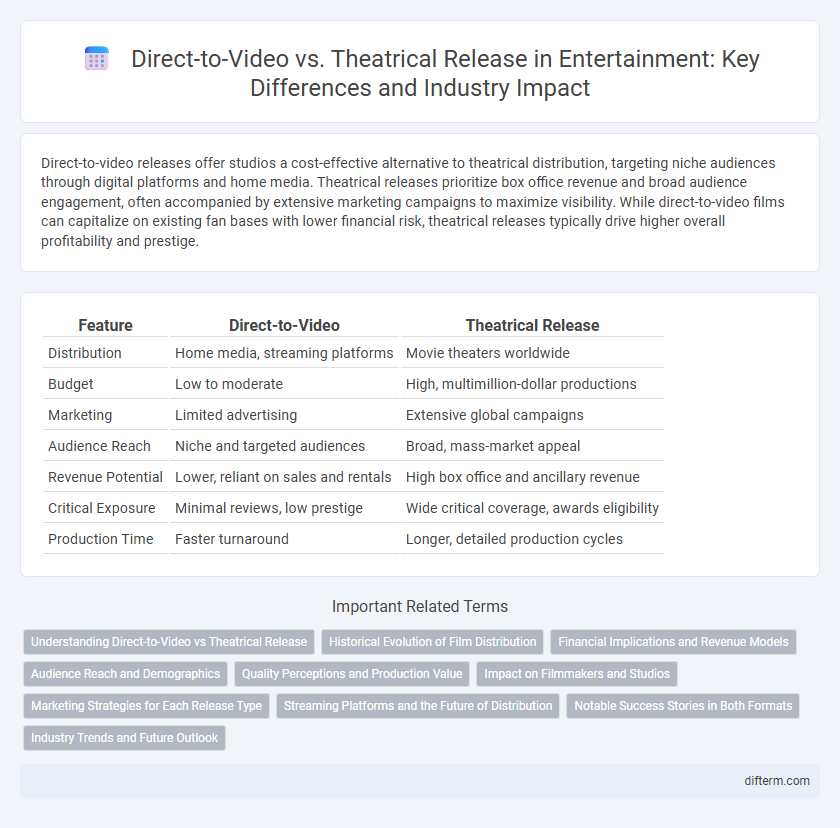Direct-to-video releases offer studios a cost-effective alternative to theatrical distribution, targeting niche audiences through digital platforms and home media. Theatrical releases prioritize box office revenue and broad audience engagement, often accompanied by extensive marketing campaigns to maximize visibility. While direct-to-video films can capitalize on existing fan bases with lower financial risk, theatrical releases typically drive higher overall profitability and prestige.
Table of Comparison
| Feature | Direct-to-Video | Theatrical Release |
|---|---|---|
| Distribution | Home media, streaming platforms | Movie theaters worldwide |
| Budget | Low to moderate | High, multimillion-dollar productions |
| Marketing | Limited advertising | Extensive global campaigns |
| Audience Reach | Niche and targeted audiences | Broad, mass-market appeal |
| Revenue Potential | Lower, reliant on sales and rentals | High box office and ancillary revenue |
| Critical Exposure | Minimal reviews, low prestige | Wide critical coverage, awards eligibility |
| Production Time | Faster turnaround | Longer, detailed production cycles |
Understanding Direct-to-Video vs Theatrical Release
Direct-to-video releases bypass traditional theaters, allowing films to reach audiences through home media platforms like DVD, Blu-ray, and streaming services, often targeting niche markets or lower-budget productions. Theatrical releases involve a film debuting in cinemas, aiming for broader exposure, higher box office revenue, and critical recognition. Understanding the distinction hinges on distribution strategy, production budget, and intended audience engagement within the entertainment industry.
Historical Evolution of Film Distribution
The historical evolution of film distribution reveals a shift from exclusive theatrical releases to the growing prominence of direct-to-video platforms, driven by advancements in home entertainment technology like VHS and DVD. This transition expanded audience access beyond cinemas while creating new revenue models, significantly impacting studios' marketing and production strategies. The rise of streaming services continues to blur traditional boundaries, influencing both theatrical and direct-to-video release dynamics in contemporary entertainment.
Financial Implications and Revenue Models
Direct-to-video releases reduce distribution and marketing costs compared to theatrical releases, increasing profit margins for studios by targeting niche audiences directly through digital and physical sales. Theatrical releases generally generate higher initial revenue through box office sales but involve substantial expenses such as theater shares, advertising, and distribution fees, impacting net profitability. Revenue models for direct-to-video rely on digital rentals, streaming rights, and home media sales, whereas theatrical releases depend heavily on ticket sales, followed by secondary income streams like streaming and merchandise licensing.
Audience Reach and Demographics
Direct-to-video releases often target niche audiences and specific demographics, leveraging digital platforms and home entertainment channels to maximize reach among dedicated fanbases, especially in genres like horror, indie, and animation. Theatrical releases typically aim for broader, more diverse audiences, capitalizing on mass marketing campaigns and the communal experience of cinemas to attract families, mainstream viewers, and international markets. Audience reach for theatrical films generally exceeds direct-to-video titles due to wider visibility and social influence, whereas direct-to-video excels in personalized engagement within segmented markets.
Quality Perceptions and Production Value
Direct-to-video releases often face perceptions of lower quality due to smaller budgets and limited production resources compared to theatrical films, which typically benefit from higher investments and extensive marketing campaigns. Theatrical releases prioritize high production values, including advanced special effects, renowned actors, and elaborate sets, enhancing audience expectations and critical reception. Despite this, some direct-to-video films achieve notable success by targeting niche markets and leveraging innovative storytelling within constrained budgets.
Impact on Filmmakers and Studios
Direct-to-video releases offer filmmakers greater creative control and faster market entry, reducing distribution costs for studios while targeting niche audiences. Theatrical releases generate higher revenue potential through box office sales and broaden studio brand visibility but involve increased marketing expenses and risk. Studios balance these distribution methods based on project scale, budget constraints, and audience reach to optimize financial returns and artistic impact.
Marketing Strategies for Each Release Type
Direct-to-video releases leverage targeted digital marketing, utilizing social media platforms and niche online communities to reach specific audience segments with cost-effective campaigns. Theatrical releases invest heavily in broad-spectrum advertising, including TV spots, outdoor billboards, and large-scale premiere events that drive widespread buzz and audience anticipation. Both strategies prioritize tailored messaging, with direct-to-video emphasizing convenience and exclusivity, while theatrical marketing highlights cinematic experience and star power.
Streaming Platforms and the Future of Distribution
Streaming platforms have revolutionized content distribution by enabling direct-to-video releases to reach global audiences instantly, bypassing traditional theatrical windows. This shift allows studios to reduce marketing and distribution costs while analyzing real-time viewer data to tailor future productions. The growing preference for streaming signals a hybrid future in entertainment where simultaneous or exclusive digital releases coexist with select theatrical runs, reshaping revenue models and audience engagement.
Notable Success Stories in Both Formats
Direct-to-video releases such as the "John Wick" series and "The Boondock Saints" gained cult followings and substantial revenue without traditional theatrical exposure. Theatrical releases like "Avatar" and "Avengers: Endgame" achieved record-breaking box office sales, demonstrating the massive appeal of cinema premieres. Both formats have proven successful by targeting distinct audience preferences and leveraging strategic distribution models.
Industry Trends and Future Outlook
Direct-to-video releases have gained momentum as studios leverage streaming platforms to reach niche audiences, reducing distribution costs and increasing profitability. Theatrical releases continue to attract large box office revenues, especially for blockbuster franchises, but face challenges from shifting consumer preferences towards home viewing experiences. Industry trends indicate a hybrid model may dominate the future, balancing exclusive theatrical windows with simultaneous or near-simultaneous digital releases to maximize audience engagement and revenue streams.
direct-to-video vs theatrical release Infographic

 difterm.com
difterm.com